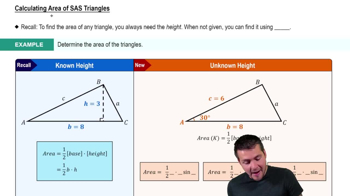Here are the essential concepts you must grasp in order to answer the question correctly.
Law of Cosines
The Law of Cosines relates the lengths of the sides of a triangle to the cosine of one of its angles. It is particularly useful for finding the length of a side when two sides and the included angle are known. The formula is c² = a² + b² - 2ab * cos(C), where C is the angle opposite side c. This concept is essential for solving triangles that are not right-angled.
Recommended video:
Area of a Triangle
The area of a triangle can be calculated using the formula A = 1/2 * a * b * sin(C), where a and b are the lengths of two sides and C is the included angle. This formula is derived from the basic definition of area and is particularly useful when two sides and the included angle are known, as in this problem. Understanding this formula is crucial for finding the area of non-right triangles.
Recommended video:
Calculating Area of SAS Triangles
Trigonometric Functions
Trigonometric functions, such as sine, cosine, and tangent, relate the angles of a triangle to the ratios of its sides. In this context, the sine function is particularly important for calculating the area of a triangle when given two sides and the included angle. Familiarity with these functions allows for the effective application of trigonometric identities and formulas in solving various problems in trigonometry.
Recommended video:
Introduction to Trigonometric Functions






